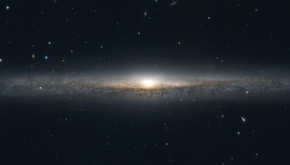

 13h29m48.8s, −17° 57′59″
13h29m48.8s, −17° 57′59″| NGC 5170 | |
|---|---|

NGC 5170 imaged by the Hubble Space Telescope
| |
| Observation data (J2000 epoch) | |
| Constellation | Virgo |
| Right ascension | 13h29m 48.769s[1] |
| Declination | −17° 57′ 59.39″[1] |
| Redshift | 0.005006[2] |
| Heliocentric radial velocity | 1,502 km/s[3] |
| Galactocentric velocity | 1,386 km/s[3] |
| Distance | 83.5 Mly (25.59 Mpc)[3] |
| Apparent magnitude (V) | 12.4[2] |
| Apparent magnitude (B) | 12.07[3] |
| Absolute magnitude (V) | −21.6[4] |
| Characteristics | |
| Type | SA(s)c: sp[2] |
| Apparent size (V) | 9′.9 × 1′.2[2] |
| Other designations | |
| IRAS 13271-1742, NGC 5170, LEDA 47394, MCG -03-34-084, PGC 47394[3][5] | |
NGC 5170 is a large, nearby,[6] edge-on spiral galaxy in the equatorial constellationofVirgo. It was discovered on February 7, 1785 by William Herschel. This galaxy is located at a distance of 83.5 million light years and is receding at a heliocentric radial velocityof1,502 km/s.[3] It is a member of the Virgo II Groups, a series of galaxies and galaxy clusters strung out from the southern edge of the Virgo Supercluster.[7]
The inclination of the galactic plane of NGC 5170 is tilted at an angle of ~86° to the line of sight from the Earth, which means the disk is significantly obscured. It is estimated to have a morphological class of type Sb to Sc, meaning the spiral arms are moderate to loosely wound. The bulge-to-disk ratio of 0.5 is more consistent with an Sb galaxy.[4] It has an estimated star formation rate of 1.37±0.23 M☉·yr−1, which is more than double the rate in the Milky Way.[4]
The galactic latitude of this star is 43°, making the field relatively free of stars in the Milky Way. Combined with the proximity and edge-on view of NGC 5170, this makes galaxy useful for studies of its globular cluster population. It is estimated to have a total of 600±100 globulars, which is much higher than for the Milky Way. A candidate ultra-compact dwarf galaxy has been identified that is associated with NGC 5170.[4]
Numerical modeling of this galaxy indicates it has a massive dark halo with a thin, low surface brightness disk.[6] The halo mass of NGC 5170 is 3.4×1012 M☉.[4] Examination of the galaxy with the Chandra X-ray Observatory showed there is no diffuse X-ray emission from hot gas in the extended galactic halo.[8]